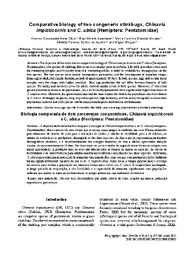Comparative biology of two congeneric stinkbugs, chinavia impicticornis and C. ubica (Hemiptera: Pentatomidae).
Comparative biology of two congeneric stinkbugs, chinavia impicticornis and C. ubica (Hemiptera: Pentatomidae).
Author(s): SILVA, C. C. A. da; LAUMANN, R. A.; MORAES, M. C. B.; AQUINO, M. F. S. de; BORGES, M.
Summary: The objective of this work was to compare the biology of Chinavia impicticornis and C. ubica (Hemiptera: Pentatomidae), two species of stinkbugs that occur as secondary pests in soybean. Life table procedures were used for evaluating nymphs, and fecundity tables for evaluating adults, in order to establish the demographics of the two species. The two species have similar demographic parameters, and the development of immature stages, from egg to adult, had similar duration periods of approximately 30 days. In both species, eggs and second?instar nymphs were the stages with higher mortality. Total egg production did not differ between females of both species. Fecundity and survival curves for adults showed similar trends in both species. However, C. ubica had greater potential to increase its populations, since its fecundity parameters were significantly higher than those of C. impicticornis . Moreover, the generational time and the time required to double the population size were shorter in C. ubica . Prolonged longevity, long oviposition period, high fecundity, and the ability to rapidly increase their populations indicate that both species can become potential pests in favorable environments.
Publication year: 2015
Types of publication: Journal article
Observation
Some of Embrapa's publications are published as ePub files. To read them, use or download one of the following free software options to your computer or mobile device. Android: Google Play Books; IOS: iBooks; Windows and Linux: Calibre.
Access other publications
Access the Agricultural Research Database (BDPA) to consult Embrapa's full library collection and records.
Visit Embrapa Bookstore to purchase books and other publications sold by Embrapa.

